Christian Bynum's Classic BMW Motorcycles: Conversion Bikes
> ..... A "/2 conversion" motorcycle is a hybrid BMW bike constructed from Münich-made and Spandau-made parts; the '60s /2 twin-loop chassis is outfitted with a '70s engine, electrical system, and drivetrain. A conversion bike can be a great way for Beemer enthusiasts familiar with the classic range of /5, /6, and /7 motorcycles to get in on the aesthetic qualities of vintage BMWs but with greater practicality, a lower front-end investment, and reduced long-term maintenance.For most regular riders who can wrench to some extent but are not necessarily up to the most daunting and involved maintenance and restoration tasks, a stock /2 is much less practical for regular riding on today's streets and highways than a /5 or later machine. Despite their bombproof reputation and their ability to kickstart and run even with a discharged battery (thanks to the nifty magneto ignition system), /2s have some notable drawbacks. The older /2 engines roller engines have difficult-to-clean oil slingers rather than a modern oil filter. They use 6-volt electrics with more limited load capacity. Their engine power and torque characteristics are not in line with requirements of high-speed highway touring. Additionally, as the value for all-original /2s continues to rise, stock Münich-built bikes are quickly becoming too valuable for many owners to want to ride on a daily commute.Thus, /2 conversion bikes enjoy a distinct popularity within the larger BMW motorcycle community because they have the vintage bike mojo and remain relatively practical at the same time. They are typically more expensive to rebuild than a later Airhead, but they have a style and a ride quality that's undeniable, and with the /5-/7 upgrades, they are as hearty and defensively aggressive on the street as the later bikes. For Beemer sidecar outfits, /2 conversions are especially favored, enjoying a sturdy chassis with a twin-loop frame and leading link fork, while having the horsepower and durable drivetrain of the '70s Airheads. Even though they are typically worth less than stock bikes in good original condition, these nicely restored conversion bikes and sidecar outfits hold there value in the used motorcycle market.
As hybrids, each conversion is an individualized work of art and engineering, a collection of unique mechanical solutions and creatively coaxed components put together to create a very special kind of riding synergy. Think how many scuttled /2s there are scattered across the globe -- languishing in disuse and exposed to the elements -- most with sound frames but seized old-style engines that will never be put back into sound working condition due to the increasing scarcity of powerplant parts. Why not make conversion bikes out of them?
I am currently assembling two conversion bikes:A /2 conversion project is not for the faint of heart; even experienced Airhead riders and restorers may find the decisions and challenges of making parts not originally designed to work together perform in desireable fashion to be an involved process with many headaches on the way to its eventual long-term payoff. By virtue of age and limited production, the necessary /2 parts can be difficult to find and expensive to purchase (as new old stock, used, or reproduction), and there are certain key components in any conversion project that must be custom-fabricated or machined to specification, taking a typical conversion restoration a step beyond all but the most involved rebuilds of stock classic or vintage motorcycles. The major engineering decisions common to all /2 conversion projects, each with its own alternatives and trade-offs, are outlined below...Frame
| Virtually all conversion projects are based on 1960-69 twin-loop swingarm frames from the following BMW models: R50/2 R50S, R50US, R60/2, R60US, R69S, and R69US. Although adventuresome souls have attemped to adapt the chassis from earlier plunger-frame twins and single-cylinder bikes with mixed success, these conversions are rare and generally not recommended. There are some key changes in the frames for these model years. In 1964, strengthening gussets were welded into the twin-loop frames to better handle torque stress and shear loads from sidecar use; in addition to their visible reinforced areas just below the swingarm pivots, these later strengthened frames sport a shortened lower main frame tube that terminates well ahead of the welded-on rectangular tank mount. During the 1967 production run, sidecar lugs were deleted from the /2 frame; therefore, those looking to build a conversion outfit should look for a '64-67 frame that has both gussets and lugs. Conversely, projects destined to become solo bikes with smaller-displacement Airhead engines (500-750cc with output up to 50HP) can use virtually any available /2 frame as a sound foundation. |
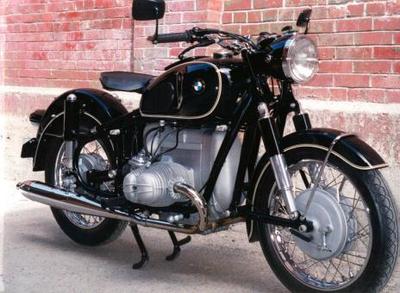
Top: Earles fork front end (Brock Downey)
Middle: Detail showing fork clearance (David Makin)
Bottom: Telescopic fork adapters (left), bearings, and races for /2
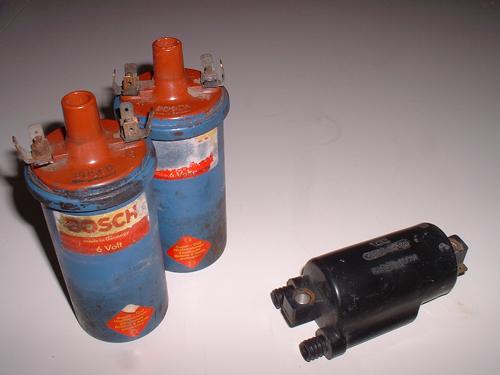  |
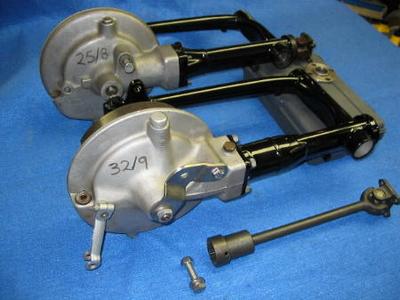
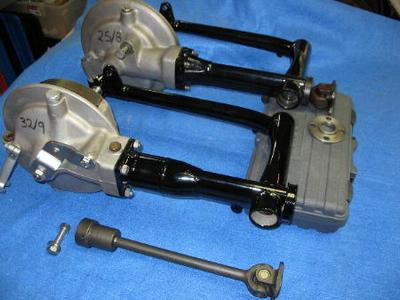
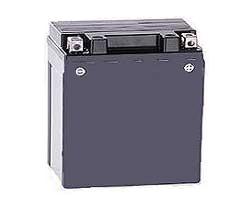
Comment